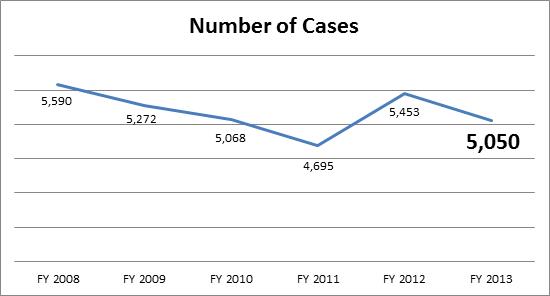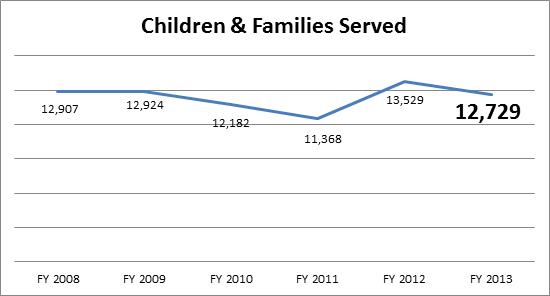The Children's Justice Centers (CJCs) are homelike facilities where physically and sexually abused children can go to be interviewed before appearing in court as witnesses against their abusers. A multi-disciplinary team coordinates the interview process and assesses the needs of the children and their families for support services.
During the 2015 General Session, the Legislature appropriated for Fiscal Year 2016, $4,022,000 from all sources for Children's Justice Centers. This is a 1.4 percent increase from Fiscal Year 2015 revised estimated amounts from all sources. The total includes $3,529,300 from the General/Education Funds, an increase of 12 percent from revised Fiscal Year 2015 estimates.
In addition to statewide compensation and internal service fund cost increases, the following appropriation adjustments were made during the 2015 General Session:
Number of cases at children's justice centers
A case is the record of all information pertaining to the investigation of allegations of physical and/or sexual abuse perpetrated on one (1) primary victim by one or more suspects. A case has only one (1) primary victim. A case may have multiple allegations, suspects, secondary victims and/or witnesses. Separate cases may be filed for distinct and unrelated episodes of abuse perpetrated on one primary victim. Number of cases is one indicator of the volume of work done by the Children's Justice Centers.

Number of individuals served at children's justice centers
Children and families served includes the primary victim, secondary victim and others served as follows:
Primary victim: the victim of alleged physical and/or sexual abuse.
Secondary victim(s): individuals, generally related to the primary victim, who have been affected (victimized) by the alleged abuse perpetrated on a primary victim. For example, a non-offending parent may be considered a secondary victim of the alleged abuse of their child.
Others served: indicates the number of people (eg, family members, etc) other than the primary victim, who receive direction intervention, interaction, referrals, and other direct assistance from CJC. This number does not include the primary victim, but may include secondary victims and family members of the primary victim. Does not include other persons who, while associated with the victim, are not directly served or assisted by the CJC.

Number of interviews conducted at children's justice centers
Interviews consist of a formal video and/or audio recorded interview conducted by a law enforcement officer, a CPS caseworker, or both, or a trained forensic interviewer, for the purposes of gathering information related to allegations of child physical and/or sexual abuse, or other crimes involving children where the child is a primary victim or a critical witness, such as in drug-related child endangerment cases. Interviews may be conducted with primary victims and witnesses. This is a measure of the total work done by Children's Justice Centers throughout the State.

Number of services conducted at children's justice centers
The top three measures identified for this line item include, 1) Number of interviews conducted at childrens' justice centers, 2) Number of cases at childrens' justice centers, and 3) Number of children and families served by the childrens' justice centers. The Attorney General has provided an explanation for each of these measures below.
Children's Justice Centers are currently operating in the following counties: Cache, Carbon, Davis, Duchesne, Emery, Grand, Iron, Salt Lake, Sanpete, Sevier, Tooele, Uintah, Utah, Wasatch, Washington, and on shared between Weber and Morgan counties.
The program is designed to foster coordination among agencies and improve communication and services for victims. Staff tracks each child's case through the investigation, hearings, and completion of treatment. The home-like environment makes children feel safe, thereby enabling them to discuss the abuse. Transcripts are provided to assist agencies and prosecutors in building stronger cases.
The Children's Justice Centers Line Item has only one program-the Children's Justice Centers Program. The greatest source of funding for this line item is the General Fund. Federal grants and dedicated credits also make up a portion of the program's funding.
COBI contains unaudited data as presented to the Legislature by state agencies at the time of publication. For audited financial data see the State of Utah's Comprehensive Annual Financial Reports.